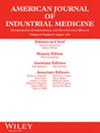Work-related asthma prevalence among US employed adults
Abstract
Background
Work-related asthma (WRA), a preventable occupational disease, can result in adverse health outcomes and employment disability, including decreased productivity, lost workdays, and job loss. Early identification of WRA cases and avoidance of further exposures is crucial for optimal management.
Objective
We estimate WRA prevalence among US workers by selected sociodemographic characteristics, industry, and occupation groups and assess the differences in adverse health outcomes, preventive care, and lost workdays between persons with WRA and those with non-WRA.
Methods
The 2020 National Health Interview Survey (NHIS) data for working adults aged ≥18 years employed in the 12 months before the survey were analyzed. Prevalence, and adjusted prevalence ratios with 95% confidence intervals were estimated using multivariate logistic regression.
Results
Of the estimated 170 million US adults working in the past year, 13.0 million (7.6%) had asthma. Among workers with asthma, an estimated 896,000 (6.9%) had WRA. WRA prevalence was highest among males, workers aged ≥55 years, those with no health insurance, those living in the Midwest, and those employed in the accommodation, food, and other services industry, and in production, installation, transportation, and material moving occupations. Workers with WRA were significantly more likely to use preventive medication and rescue inhalers, and to experience adverse health outcomes and lost workdays than workers with non-WRA.
Conclusion
Early identification of WRA cases, assessment of workplace exposures, and implementation of targeted interventions that consider the hierarchy of controls are critical to preventing future WRA cases and associated adverse health consequences.

 求助内容:
求助内容: 应助结果提醒方式:
应助结果提醒方式:


